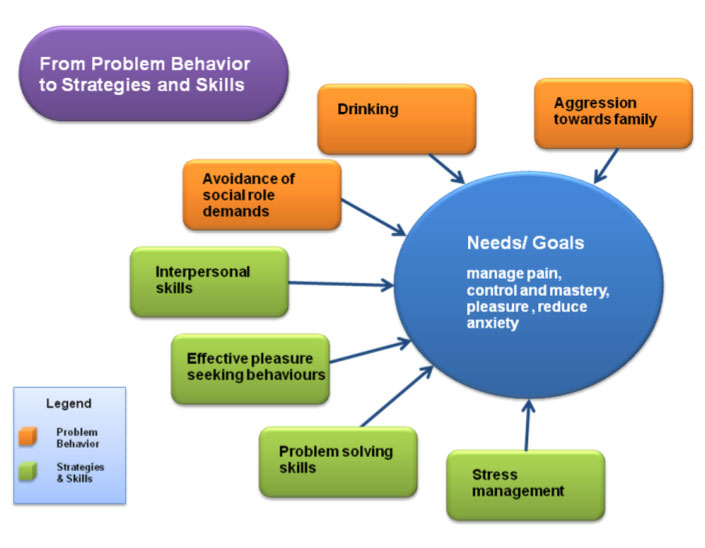Addiction Counseling and SSLD
A. Ka Tat Tsang, Ph.D.
November 14, 2008
Substitute, not suppress!
The key idea in the SSLD approach to addiction counseling is that addiction is motivated. Addiction behaviors usually serve to meet some personal needs, be it peer approval, pain management, stress control, or pleasurable sensation. Even when we believe that there is a neurophysiological basis to addiction, which often is the case, we explain addictive behavior in terms of a desired outcome - be it the firing of certain groups of neurons in particular parts of the brain. The challenge for addiction counselors is to find alternative strategies that will allow the person with addiction to achieve a similar outcome, or some combination of gratifying experience that will give a similarly potent effect. The main idea here is building a life that will offer gratifying experiences, and not simply quitting a bad habit. The diagram below shows the situation of a man who uses alcohol, and has used violence against his wife and his children. He systematically avoids social role demands such as work, housework, and childcare responsibilities. Although he has done and said things to harm his family, he considers himself a victim. He cited his own childhood abuse as the reason for all his current problems, and he believes that drinking is the only thing he can do to cope with all the pains he experienced in life. He believes that most people do not like him, and no one, including his current family, ever loves him. He does not have close friends, and does not enjoy interacting with people. The diagram shows how his addiction and associated behaviors are all targeting certain goals, and effective SSLD intervention aims at building alternative strategies and skills that are functionally related, in that they can serve similar functions by targeting the same goals.
The first step in SSLD intervention, therefore, is an assessment aiming at discovering what the addiction and associated behaviors are doing for the individual. We do not assume that everyone gets addicted to the same thing for the same reason, which is the assumption made in group-based research, theory, and practice models. Instead, we recognize that people use different behavior to achieve the same goal; and they also use the same behavior to do different things. The person in our case example drinks to manage pain, and often drinks alone. Some other people drink to gain and foster a sense of belonging. There are people who experience similar pain and difficulty in relationships, but use very different strategies to cope with them.
Back to the top

A SSLD intervention program recognizes addictive behavior as purposeful and functional. We use an educational rather than a medical or disease-based paradigm. The needs and goals that addiction behavior targets, such as seeking stimulation, pleasure, and sense of control, or reducing pain, stress, and anxiety, are not problematic in themselves. The problem is with the strategy adopted (addiction), which is costly and affects other areas of goal attainment (e.g., achievement, health). While we stay goal directed, our thinking is not restricted by the addiction. We do not just focus on getting rid of the addiction. In most successful cases, we work on expanding the repertoire of effective strategies and skills of our clients, so that they become more capable in attaining what they need in life. This process will allow clients to become less dependent on addictive strategies such as substance use or gambling as the only means available, but provide them with more options to choose from.
Once we have a good assessment of the client's needs, we will have a good understanding of the function of the addictive behavior. The next step is to translate these needs into attainable goals within the real-life context of the client. In most cases we will see that clients do not have many alternative strategies for these goals, and that is why addictive behavior has become the preferred option. Our clinical formulation usually consists of a design for learning and developing relevant strategies and skills to address those goals, so that addiction stops being the only option.
In the example above, the clients can learn to understand his emotional experience better and develop new strategies to deal with them. In terms of gaining control over his environment and getting people to respond to his needs, aggression and violence are the only means he knows. He needs to learn interpersonal and relationship skills, which he has not really mastered through his life. Given his restricted life chances and limited social exposure, he has not really explored different strategies of pleasure. There are many new strategies and skills that he can learn and develop in order to address his needs and goals effectively.
Back to the top